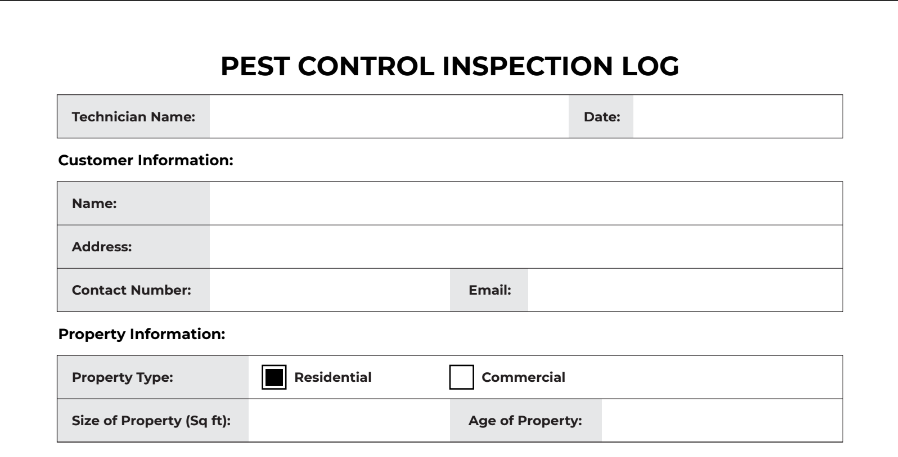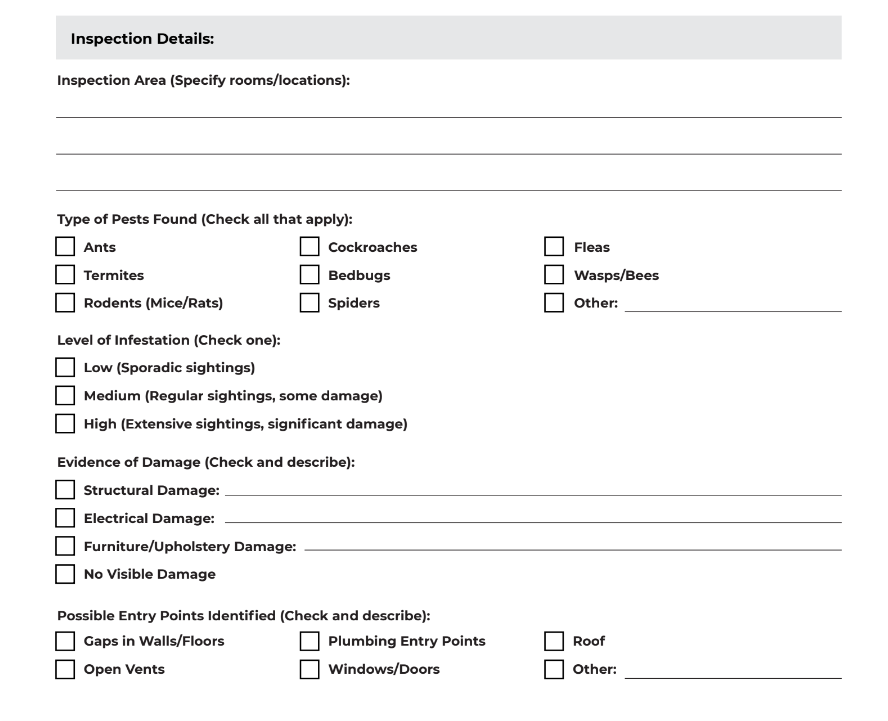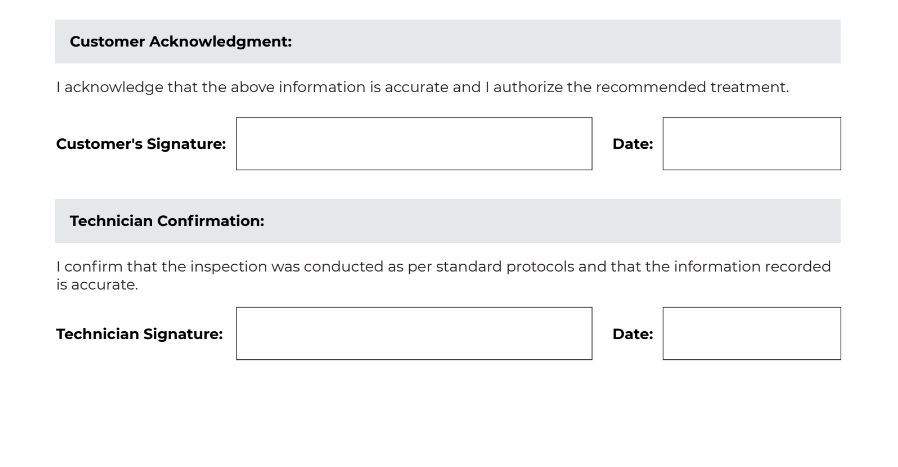Pest Control Inspection Checklist Template (+Free PDF Download)
Pest control technicians perform thorough inspections to keep bugs at bay in customers’ homes and workplaces.
A pest control inspection checklist helps technicians inspect efficiently, perform high-quality work, and deliver superior customer service. Inspection checklists ensure techs don’t overlook key areas or telltale signs of a pest infestation.
Properly documented inspections show customers what pest control services they need. It’s the first step to gaining more customers, annual contracts, and revenue for your business.
Use this pest control inspection template to streamline inspections and discover how to optimize your pest control business for greater profit and growth.
How to Perform a Thorough Pest Control Inspection

Pest control inspections involve a thorough visual check of a building’s interior and exterior for evidence of pests or favorable conditions for potential pest infestations. The inspection enables technicians to identify solutions to eliminate or prevent pests.
Follow these steps to conduct a thorough pest control inspection.
1. Pre-Inspection Preparation
Before beginning an inspection, techs should familiarize themselves with property history, such as past cockroach or bed bug infestations.
Business software, such as FieldRoutes® pest control software, makes it easy for techs to view customer information and visit notes, streamlining the inspection process.
Pre-inspection preparation includes:
Assemble equipment: Techs must possess the right equipment, such as proper personal protective equipment, flashlights or headlamps, magnifiers, telescoping mirrors, hand tools, moisture meters, and ladders. Company trucks or vans must be clean, stocked, and organized so techs can quickly find what they need.
Prepare documentation: A digital tablet or notebook enables techs to make inspection notes. A camera provides additional inspection documentation. Other important documents include an inspection checklist and pest control service agreements for one-time or recurring services.
Communicate with customers: Before beginning an inspection, techs should inform customers where they will go and what they will do and report their findings to the customer upon completion.
Proper preparation ensures an efficient inspection and establishes customer expectations, which is critical to customer satisfaction.
2. Site Survey
Site surveys identify signs of pest activity and enable technicians to recommend effective pest control methods.
A thorough site survey includes inspecting:
Slope of the land and water drainage
Landscaping, vegetation, and mulch for pest hiding places or moisture
Eaves and soffits for cracks or holes
Gutters for debris, clogs, or leaks
Garbage containers and recycling receptacles
Outdoor drainage systems
Containers and outdoor equipment holding standing water
A site survey identifies exterior issues, such as standing water for mosquito breeding grounds, crevices for wasp or yellow jacket nests, and improper trash storage that attracts raccoons and other scavengers.
3. Entry Points Assessment
Inspecting interior and exterior entry points identifies openings where insects can enter and make themselves at home.
Inspect these entry points to prevent pests:
Garage doors for proper closure
Exterior doors for weatherstripping and gaps
Windows for gaps in the frame or tears in the screens
Basement window wells for signs of pests
Attic or crawl space vents for proper screening
Interior vents and fans
Proper entry point assessment identifies potential rodent or insect entryways so pest control techs can recommend repairs and solutions.
4. Interior Inspection
Interior inspections ensure a pest-free environment. Typically, interior inspections focus on commonly infested areas, such as kitchens, bathrooms, storage areas, and basements.
Techs should look for insects and signs of pests, such as droppings, to identify the type of pest infestation. They should also locate any odors, such as musty smells, which could indicate pests or a moisture issue.
An interior inspection checks:
Baseboards and toe kicks for gaps
Kitchen and break room countertops
Cupboards and food storage areas
Areas around the refrigerator and stove
Food residue on the floor, walls, or counters
Basements for rodent droppings, webs, nests, or moisture
A detailed interior inspection helps techs recommend proper pesticides and effective pest control methods. To help prevent pest infestations, technicians can advise customers on storing food properly and maintaining a clean kitchen through regular sweeping and mopping.
5. Structural Review
A pest control inspection identifies structural flaws, such as cracks in the foundation or gaps in the walls, where pests can enter.
A structural inspection includes observing:
Foundation for cracks or moisture
Attached decks or porches
Brick or vinyl siding for gaps, cracks, and holes
Roofs for loose shingles or holes
Attics for signs of pests, gaps, and holes
Crawl spaces for signs of insects, rodents, gaps, or moisture
Moisture can attract wood-destroying insects like termites, cockroaches, earwigs, and spiders. Without an inspection, pest problems could continue unnoticed in unfrequented areas.
6. Utilities Inspection
A utilities inspection identifies potential entryways for pests in areas housing HVAC, plumbing, and electrical systems.
Techs typically look for gaps where pests can enter. In the case of water sources, potential moisture could attract pests such as cockroaches, ants, or drain flies.
To perform a utilities inspection, check around:
Pipes for gaps and holes in the wall
Faucets and plumbing for leaks and moisture
Washers and dryers
Water heaters
Air conditioning and heating units
Fuse boxes
Practice safety procedures when inspecting near equipment, especially electrical equipment and appliances.
Pest Control Inspection Best Practices

Implement pest control inspection best practices to improve technician efficiency, inspection quality, and customer service.
Pest control inspection best practices include:
Utilize pest control software
Pest control business software, such as FieldRoutes, provides the tools to streamline the process for termite inspections, warranties, and renewals with licensed access to NPMA-33. A mobile app enables techs to create diagrams and record detailed information about pest activity and pest-conducive conditions.
Establish inspection procedures
Consistent procedures ensure high-quality inspections. Train techs to follow a procedure to methodically complete inspections, such as beginning with a property’s site and proceeding to structural and interior inspections. Checklists guide techs through the inspection process.
Document findings
Document findings using tablets, inspection forms, and pictures. Documentation provides evidence of pest activity and helps your team stay in the loop.
Kwik Kill Pest Control in Madison, Wis., found FieldRoutes boosted their ability to resolve issues in the field quickly.
“If a technician is at a house and they can’t do something for a reason beyond our control, they can take that picture and attach it, and then we make a red note on the account,” says Breanna Neerland, Kwik Kill Pest Control Operations Manager. “We see that in the office, and we can go look at it.”
Documentation also helps pest control companies measure the effectiveness of pest control management solutions, especially when using an integrated pest management (IPM) approach.
Communicate with the customer
Pest control businesses using FieldRoutes can share inspection findings, in-depth property notifications, and trend reports with customers through their customer portal so they can choose the right level of service.
Regulatory Requirements for Pest Control Inspections

Pest control businesses must follow regulatory requirements depending on the type of inspection and state rules.
For real estate transactions involving certain types of loans, such as HUD, pest control companies must fill out a NPMA-33 WDI inspection report if they spot activity or damage from wood-destroying insects, such as termites, carpenter ants, carpenter bees, and reinfesting wood boring beetles, according to the National Pest Management Association.
Other lenders may require a wood-destroying insect inspection report. Some states, such as California, require their own standard report forms for wood-destroying organisms.
Failure to follow reporting requirements could result in legal issues and damage your company’s professional reputation.
Why You Should Use Pest Control Inspection Software
Instead of siloed software solutions that hinder efficiency, comprehensive pest control software integrates your operations to simplify your day-to-day tasks.
FieldRoutes pest control software streamlines all operations, empowering pest control operators to work efficiently, improve customer service, increase sales, and boost profits.
FieldRoutes’ industry-specific tools enable pest control businesses to:
Easily schedule with drag-and-drop appointments
Optimize intelligent routing and save on fuel costs
Assign tasks to teams and facilitate better communication
Automate customer appointment reminders
Speed up collections with automated customer payment reminders through text, email, or voicemail
Accept online customer payments or immediate payments through AutoPay
Gain a clear view of business performance with real-time data
For companies servicing commercial or multi-unit properties, FieldRoutes simplifies reporting compliance and allows businesses to merge and link multiple service addresses to consolidate billing.
Achieve Maximum Efficiency With Pest Control Operations Software
FieldRoutes pest control software does much more than streamline inspections and reporting. It provides the tools for your pest control business to boost profitability and grow quickly.
User-friendly features save time and help your team work more effectively. Whether you’re looking to get more done each day or expand your business into new branches or verticals, FieldRoutes provides the solution for optimal growth.
Ready to take your pest control business to the next level? Schedule a demo today.